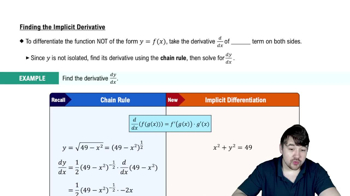Table of contents
- 0. Functions7h 52m
- Introduction to Functions16m
- Piecewise Functions10m
- Properties of Functions9m
- Common Functions1h 8m
- Transformations5m
- Combining Functions27m
- Exponent rules32m
- Exponential Functions28m
- Logarithmic Functions24m
- Properties of Logarithms34m
- Exponential & Logarithmic Equations35m
- Introduction to Trigonometric Functions38m
- Graphs of Trigonometric Functions44m
- Trigonometric Identities47m
- Inverse Trigonometric Functions48m
- 1. Limits and Continuity2h 2m
- 2. Intro to Derivatives1h 33m
- 3. Techniques of Differentiation3h 18m
- 4. Applications of Derivatives2h 38m
- 5. Graphical Applications of Derivatives6h 2m
- 6. Derivatives of Inverse, Exponential, & Logarithmic Functions2h 37m
- 7. Antiderivatives & Indefinite Integrals1h 26m
- 8. Definite Integrals3h 25m
4. Applications of Derivatives
Implicit Differentiation
Problem 3.8.37
Textbook Question
27–40. Implicit differentiation Use implicit differentiation to find dy/dx.
6x³+7y³ = 13xy
 Verified step by step guidance
Verified step by step guidance1
Differentiate both sides of the equation 6x³ + 7y³ = 13xy with respect to x, applying the product rule on the right side and the chain rule on the left side for the y terms.
For the left side, differentiate 6x³ to get 18x² and for 7y³, use the chain rule to get 21y²(dy/dx).
On the right side, apply the product rule to 13xy, which gives you 13(y + x(dy/dx)).
Set the derivatives from both sides equal to each other: 18x² + 21y²(dy/dx) = 13(y + x(dy/dx)).
Rearrange the equation to isolate dy/dx, factoring it out and solving for dy/dx to express it in terms of x and y.
Recommended similar problem, with video answer:
 Verified Solution
Verified SolutionThis video solution was recommended by our tutors as helpful for the problem above
Video duration:
7mPlay a video:
Was this helpful?

 5:14m
5:14mWatch next
Master Finding The Implicit Derivative with a bite sized video explanation from Nick
Start learningRelated Videos
Related Practice



